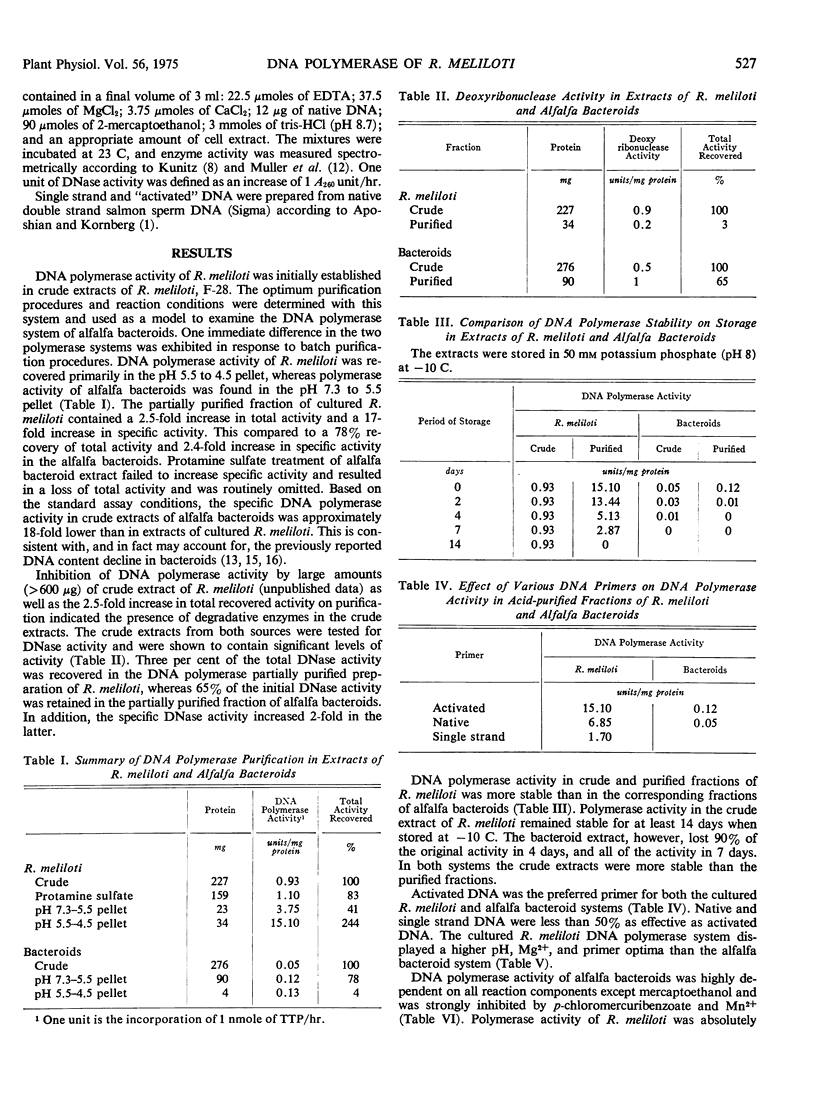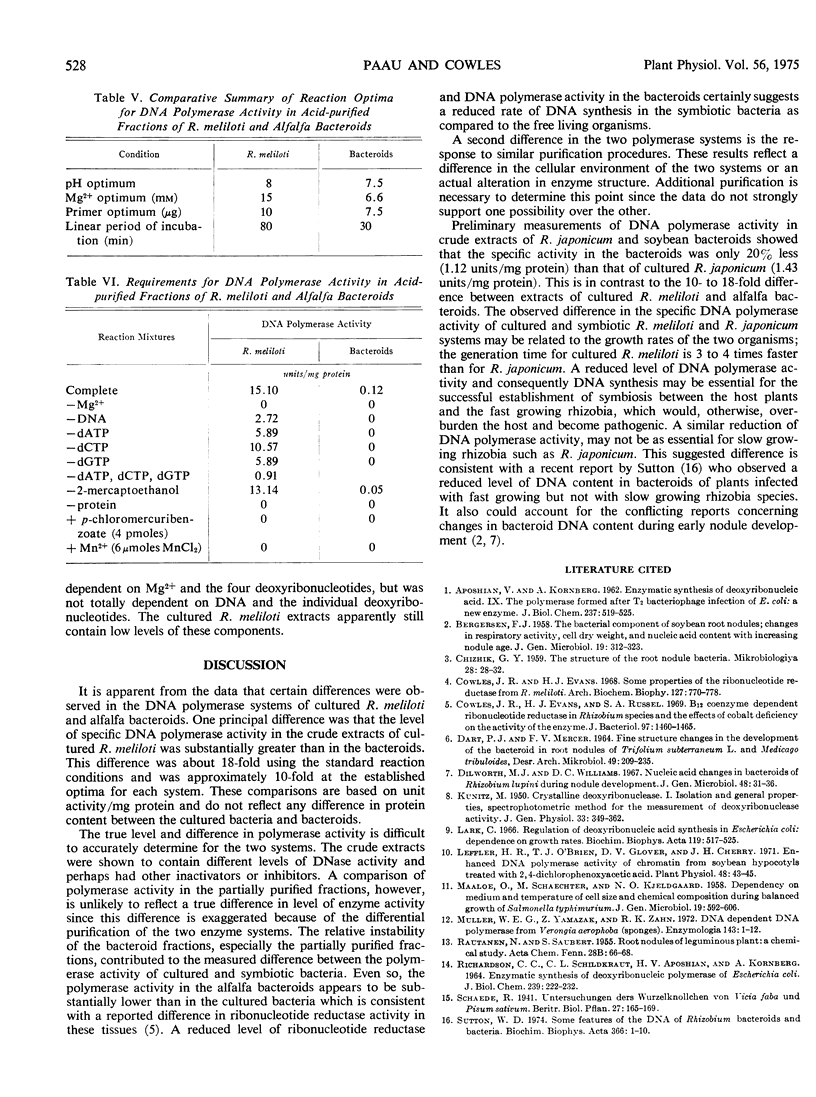Abstract
DNA dependent-DNA polymerase activity was established and partially purified from extracts of cultured Rhizobium meliloti, F-28, and nodule bacteroids (R. meliloti, F-28) of alfalfa plants (Medicago sativa). Polymerase activity in the partially purified fractions showed characteristic dependence on Mg2+, DNA, and a full complement of deoxyribonucleoside triphosphates. DNase activity, preference of “activated” double strand DNA, and inhibition by p-chloromercuribenzoate and MnCl2 were responses common to both systems. The two systems however did exhibit some differences in pH, Mg2+, and primer optima. Polymerase activity in crude extracts of the cultured bacteria was more stable and had 10- to 18-fold greater specific activity than the bacteroid extracts. Preliminary measurements of specific DNA polymerase activity in crude extracts of cultured Rhizobium japonicum were not significantly higher than that in the crude extracts of soybean nodule bacteroids. A possible correlation between DNA synthesis and the successful establishment of rhizobia-legume symbiosis is discussed.
Full text
PDF


Selected References
These references are in PubMed. This may not be the complete list of references from this article.
- APOSHIAN H. V., KORNBERG A. Enzymatic synthesis of deoxyribonucleic acid. IX. The polymerase formed after T2 bacteriophage infection of Escherichia coli: a new enzyme. J Biol Chem. 1962 Feb;237:519–525. [PubMed] [Google Scholar]
- BERGERSEN F. J. The bacterial component of soybean root nodules; changes in respiratory activity, cell dry weight and nucleic acid content with increasing nodule age. J Gen Microbiol. 1958 Oct;19(2):312–323. doi: 10.1099/00221287-19-2-312. [DOI] [PubMed] [Google Scholar]
- Cowles J. R., Evans H. J., Russell S. A. B12 coenzyme-dependent ribonucleotide reductase in Rhizobium species and the effects of cobalt deficiency on the activity of the enzyme. J Bacteriol. 1969 Mar;97(3):1460–1465. doi: 10.1128/jb.97.3.1460-1465.1969. [DOI] [PMC free article] [PubMed] [Google Scholar]
- Cowles J. R., Evans H. J. Some properties of the ribonucleotide reductase from Rhizobium meliloti. Arch Biochem Biophys. 1968 Sep 20;127(1):770–778. doi: 10.1016/0003-9861(68)90288-9. [DOI] [PubMed] [Google Scholar]
- KUNITZ M. Crystalline desoxyribonuclease; isolation and general properties; spectrophotometric method for the measurement of desoxyribonuclease activity. J Gen Physiol. 1950 Mar;33(4):349–362. doi: 10.1085/jgp.33.4.349. [DOI] [PMC free article] [PubMed] [Google Scholar]
- Lark C. Regulation of deoxyribonucleic acid synthesis in Escherichia coli: dependence on growth rates. Biochim Biophys Acta. 1966 Jun 22;119(3):517–525. doi: 10.1016/0005-2787(66)90128-6. [DOI] [PubMed] [Google Scholar]
- Leffler H. R., O'brien T. J., Glover D. V., Cherry J. H. Enhanced deoxyribonucleic Acid polymerase activity of chromatin from soybean hypocotyls treated with 2,4-dichlorophenoxyacetic Acid. Plant Physiol. 1971 Jul;48(1):43–45. doi: 10.1104/pp.48.1.43. [DOI] [PMC free article] [PubMed] [Google Scholar]
- Müller W. E., Yamazaki Z. I., Zahn R. K. DNA dependent DNA polymerase from Verongia aerophoba. Enzymologia. 1972 Jul 31;43(1):1–12. [PubMed] [Google Scholar]
- RICHARDSON C. C., SCHILDKRAUT C. L., APOSHIAN H. V., KORNBERG A. ENZYMATIC SYNTHESIS OF DEOXYRIBONUCLEIC ACID. XIV. FURTHER PURIFICATION AND PROPERTIES OF DEOXYRIBONUCLEIC ACID POLYMERASE OF ESCHERICHIA COLI. J Biol Chem. 1964 Jan;239:222–232. [PubMed] [Google Scholar]
- SCHAECHTER M., MAALOE O., KJELDGAARD N. O. Dependency on medium and temperature of cell size and chemical composition during balanced grown of Salmonella typhimurium. J Gen Microbiol. 1958 Dec;19(3):592–606. doi: 10.1099/00221287-19-3-592. [DOI] [PubMed] [Google Scholar]


